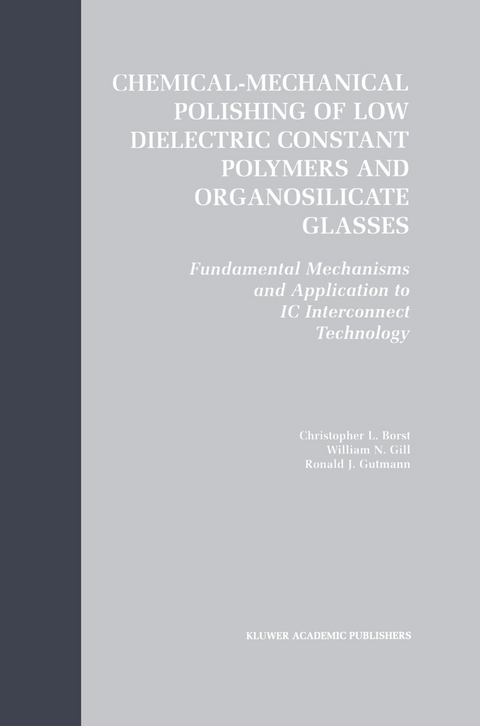
Chemical-Mechanical Polishing of Low Dielectric Constant Polymers and Organosilicate Glasses
Springer-Verlag New York Inc.
978-1-4020-7193-5 (ISBN)
The focus of this book is to merge the complex CMP models and mechanisms that have evolved in the past decade with recent experimental results with copper and low-kappa CMP to develop a comprehensive mechanism for low- and high-removal-rate processes. The result is a more in-depth look into the fundamental reaction kinetics that alter, selectively consume, and ultimately planarize a multi-material structure during Damascene patterning.
1: Overview of IC Interconnects.- 1.1 Silicon Ic Beol Technology Trends.- 1.2 Sia Roadmap Interconnect Projections.- 1.3 Low-? Requirements and Materials.- 1.4 Need for Low-? CMP Process Understanding.- 1.5 Summary.- 1.6 References.- 2: Low-? Interlevel Dielectrics.- 2.1 Fluorinated Glasses.- 2.2 Silsesquioxanes.- 2.3 Organosilicate Glasses.- 2.4 Polymers.- 2.5 Fluorinated Hydrocarbons.- 2.6 Nanoporous Silica Films.- 2.7 Other Porous Materials.- 2.8 References.- 3: Chemical-Mechanical Planarization (CMP).- 3.1 CMP Process Description.- 3.2 CMP Processes With Copper Metallization.- 3.3 CMP of Low-? Materials.- 3.4 CMP Process Models.- 3.5 Langmuir-Hinshelwood Surface Kinetics in CMP Modeling.- 3.6 References.- 4: CMP of BCB and SiLK Polymers.- 4.1 Removal Rate in Copper Slurries.- 4.2 Surface Roughness.- 4.3 Surface and Bulk Film Chemistry.- 4.4 Effect of Cure Conditions on BCB and Silk Removal.- 4.5 Effect of CMP and BCB and Silk Film Hardness.- 4.6 Comparison of BCB and Silk CMP with other Polymer CMP.- 4.7 Summary.- 4.8 References.- 5: CMP of Organosilicate Glasses.- 5.1 Effect of Film Carbon Content.- 5.2 Surface Roughness.- 5.3 Surface and Bulk Film Chemistry.- 5.4 Copper Damascene Patterning with OSG Dielectrics.- 5.5 Summary.- 5.6 References.- 6: Low-? CMP Model Based on Surface Kinetics.- 6.1 Isolation of the Chemical Effects in Silk CMP.- 6.2 CMP with Simplified “Model” Silk Slurries.- 6.3 Phenomenological Model for CMP Removal.- 6.4 Five Step Removal Model Using Modified Langmuir-Hinshelwood Kinetics for Silk CMP.- 6.5 Two Step Removal Model Using Heterogeneous Catalysis for Silk CMP.- 6.6 Extendibility of Model to Describe the CMP of Other Materials.- 6.7 References.- 7: Copper CMP Model Based Upon Fluid Mechanics and Surface Kinetics.- 7.1 FlowModel.- 7.2 Copper Removal Model.- 7.3 Model Results.- 7.4 Copper CMP Experiments with Potassium Dichromate Based Slurry.- 7.5 Summary.- 7.6 References.- 8: Future Directions in IC Interconnects and Related Low-? ILD Planarization Issues.- 8.1 Planarization of Interconnects with Ultra Low-? ILDS.- 8.2 Alternatives for the Post-Copper/Ultra Low-? Interconnect Era.- 8.3 3D Wafer-Scale Integration Using Dielectric Bonding Glues and Inter-Wafer Interconnection with Copper Damascene Patterning.- 8.4 Summary and Conclusions.- 8.5 References.- Appendices.- Appendix A: Experimental Procedures and Techniques.- Appendix B: XPS Depth-Profile Data.- Appendix C: CMP Data for Anomalous Silk Removal Behavior.
| Erscheint lt. Verlag | 30.9.2002 |
|---|---|
| Zusatzinfo | XIV, 229 p. |
| Verlagsort | New York, NY |
| Sprache | englisch |
| Maße | 155 x 235 mm |
| Themenwelt | Technik ► Maschinenbau |
| ISBN-10 | 1-4020-7193-0 / 1402071930 |
| ISBN-13 | 978-1-4020-7193-5 / 9781402071935 |
| Zustand | Neuware |
| Haben Sie eine Frage zum Produkt? |
aus dem Bereich


